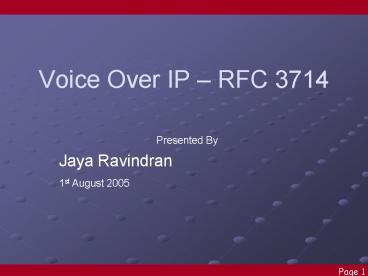Voice Over IP RFC 3714 - PowerPoint PPT Presentation
1 / 16
Title:
Voice Over IP RFC 3714
Description:
TFRC has a much lower variation of throughput over time compared with TCP. ... RTP payload format allows multiple AMR frames into the same packet. ... – PowerPoint PPT presentation
Number of Views:42
Avg rating:3.0/5.0
Title: Voice Over IP RFC 3714
1
Voice Over IP RFC 3714
- Presented By
Jaya Ravindran
1st August 2005
Page 1
2
Voice Over IP RFC 3714
Overview
- Introduction
- End to end congestion control for best effort
voice traffic In the internet - Concerns
- Fairness
- User Quality
- Congestion Collapse
- Current Efforts
- Recommendations
Summer 2005 Presentation
Page 2
3
Voice Over IP RFC 3714
Motivation Why ?
Callee
Caller
Best Effort
Qos Employed
Qos Employed
Summer 2005 Presentation
Page 3
4
Voice Over IP RFC 3714
Which is the bottleneck ?
Access Links
Access Links
Last Hop
Host
Bottleneck
Avoid congestion collapse along the entire path
including the access links.
Result ! - Bandwidth wasted Possible Measures
Terminate ? Suspend ?
On Persistent high packet drop rate
As VOIP requires a Minimum sending rate
Summer 2005 Presentation
Page 4
5
Voice Over IP RFC 3714
Persistent packet drop rate A problem
- Congestion collapse Important In VoIP
- Congestion collapse Occur mostly for flows that
traverse multiple congested links. - For a VoIP network Both ends of the VoIP call
may be on a congested broadband connection, such
as DSL, Backbone or Transoceanic link. - User Quality
Drop occurs randomly, so nobody gets benefited
Summer 2005 Presentation
Page 5
6
Voice Over IP RFC 3714
Rule of thump
- When packet loss rate gt 20
- Audio quality of VoIP is degraded beyond
usefulness. - TCP can compete leading to jitter. (1500 packet
size) - Better to terminate.
Summer 2005 Presentation
Page 6
7
Voice Over IP RFC 3714
Fairness
- Consider
- Multiple VoIP sources.
- Multiple TCP sources.
- Bottom line VoIP crowds out TCP
Possible Solutions
- Call Rejection Does not exist for best effort
- End to end congestion control
Summer 2005 Presentation
Page 7
8
Voice Over IP RFC 3714
Current efforts in the IETF
- An upgrade of RTP specification
- TFRC
- DCCP
- Adaptive Rate Audio Codecs
- Differentiated Services Related Topics
Summer 2005 Presentation
Page 8
9
Voice Over IP RFC 3714
RTP RFC 3551
- If best-effort service is being used, RTP
receivers SHOULD monitor packet loss to ensure
that the packet loss rate is within acceptable
parameters. Packet loss is considered acceptable
if a TCP flow across the same network path and
experiencing the same network conditions would
achieve an average throughput, measured on a
reasonable timescale, that is not less than the
RTP flow is achieving. - In essence, this requirement states that it is
not acceptable to deploy an application (using
RTP or any other transport protocol) on the
best-effort Internet which consumes bandwidth
arbitrarily and does not compete fairly with TCP
within an order of magnitude. (Timescale
Throughput)
Summer 2005 Presentation
Page 9
10
Voice Over IP RFC 3714
TFRC RFC 3267 - Equation based congestion
control
- TFRC has a much lower variation of throughput
over time compared with TCP. - Suitable for applications such as telephony or
streaming media where a relatively smooth sending
rate is of importance. - TFRC works for fixed packet size and vary their
sending rate in packets per second. - Some audio application
- - Need fixed interval of time between packets.
- - Can vary their packet size instead of packet
rate. - TFRC-PS (TFRC Packet Size)
- - Meets the above requirement.( Fixed
PPS,Variable - Payload Size)
- - Hence, can be effective for congestion
control. - - Can be used in a transport protocol such as
RTP.
Summer 2005 Presentation
Page 10
11
Voice Over IP RFC 3714
DCCP RFC 3267 - Datagram Congestion Control
Protocol
- For unreliable Flows.
- Applications can specify
- TCP like
- TFRC like services.
- Congestion Control Identifiers
- CCID2 TCP like
- CCID3 TFRC like
- CCID4 TFRC-PS - future
Summer 2005 Presentation
Page 11
12
Voice Over IP RFC 3714
Adaptive Rate Audio Codec
- Fixed codecs not helpful.
- Low/Adaptive rate preferable.
Summer 2005 Presentation
Page 12
13
Voice Over IP RFC 3714
Adaptive Rate Audio Codecs
- Varies its encoded frame size. (Between 11 32)
- Each frame size is 20 ms of speech.
- RTP payload format allows multiple AMR frames
into the same packet. - Reduces transmission rate during silence
periods. - Has employed FCE and frame interleaving.
- Along with TFRC-PS, can provide effective
congestion control mechanism. - Highly experimented.
- Improves the scalability of VoIP or TCP sharing a
congested link.
Summer 2005 Presentation
Page 13
14
Voice Over IP RFC 3714
Assessing Minimum Acceptable sending Rate
- For an AMR application with minimum rate M
- Is M acceptable ?
- Is the limitation in PPS or BPS ?
- For a persistent packet drop D when should the
application terminate ? - Consider TCP having the same drop as VoIP
- Sending rate of VoIP gtgt TCP, terminate.
- Reasons
- Avoiding Congestion Collapse.
- Fairness for TCP like traffic.
- Minimum service not achieved.
Summer 2005 Presentation
Page 14
15
Voice Over IP RFC 3714
Recommendations
- Fixed rate codec Ability to specify minimum bit
throughput. - Adaptive variable bit rate codec, supporting VoIP
on shared internet. - ECN to detect congestion.
- Ensure receiving application is capable of
getting this information from lower layer.
Summer 2005 Presentation
Page 15
16
Voice Over IP RFC 3714
Thank You
Summer 2005 Presentation
Page 16































